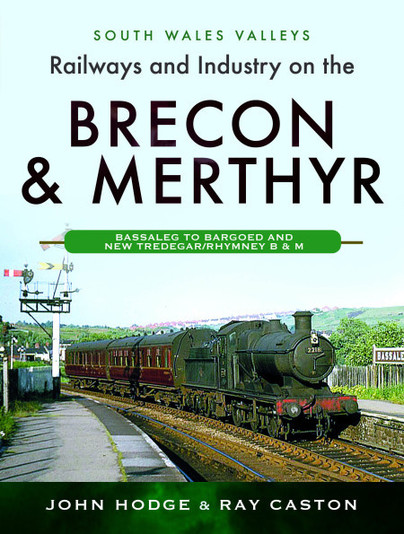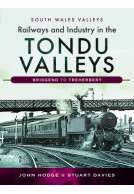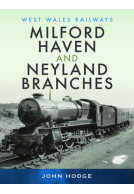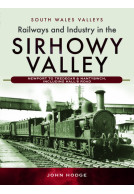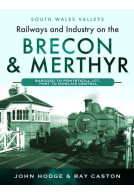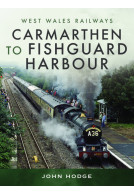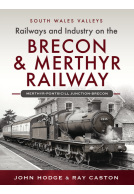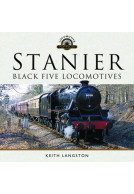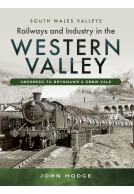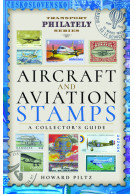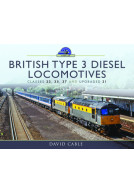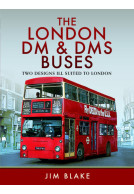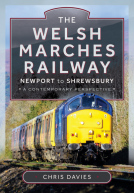Railways and Industry on the Brecon & Merthyr (eBook)
Bassaleg to Bargoed and New Tredegar/Rhymney B & M
Imprint: Pen & Sword Transport
Series: South Wales Valleys
File Size: 25.4 MB (.epub)
Pages: 248
ISBN: 9781399096065
Published: 27th April 2022
| Other formats available - Buy the Hardback and get the eBook for £1.99! | Price |
|---|---|
| Railways and Industry on the Brecon… Hardback Add to Basket | £26.25 |
This book, as part of the South Wales Valleys series, deals with the former Brecon & Merthyr Railway line which ran from Bassaleg (north of Newport) to Brecon and Rhymney B&M, the latter line being closed north of New Tredegar in 1930 due to a landslide, one of several in that area. The most important and lucrative traffic was of course coal from the many collieries on the line, much bound for Newport Docks, though there was a regular passenger service both to Brecon and New Tredegar which ran to Rhymney B&M before 1930. At Machen the line diverted to Caerphilly and Pontypridd again with coal and passenger services, mostly covered by auto trains. Each location along all lines in the area is covered in detail with copious photographs to illustrate, and an OS Map from the start of the 20th C. to present a detailed coverage of the area around each location. The line is still open from Bassaleg to Machen Quarry for occasional trains of stone traffic using modern traction and wagons.
"Thoroughly recommended coverage of an under-recorded line..."
The Journal of The Stephenson Locomotive Society
“Another comprehensive collection of images and text… There then follows a journey along the lines, each section described with the aid of maps and filled with hundreds of superb photographs covering the time span from early days to final days, all of the best quality and reproduced on quality paper such that I find it difficult to find the words to convey the excellence of the book. The authors have excelled themselves in finding the quantity and quality of the images that I find it difficult to put the books down.”
Great Eastern Railway Society Newsletter
The Brecon and Merthyr line from Newport to Brecon was a pre-Beeching closure that ended a much beloved line of great character and contrasts. This is the first of three volumes in the format that John Hodge has developed and covers the southern section that had the stereo-typical South Wales valley colliery scene interspersed with surprisingly rural sections. Both authors are eminently qualified from personal experience and this is very evident in the depth and breadth of the text covering history and operation supporting the comprehensive photograph coverage (including the post-closure freight traffic) that John Hodge has assembled. The colour photographs include a summer 1962 project by Alan Jarvis to photograph the 7.7pm from Cardiff that was limited only by light levels and the range of his motorbike! The text is supported by 6 inch OS maps and my only criticism is that the contrast of some of these maps is inadequate, making them difficult to understand. A minor point is that the 1922 photographs of Patterson Rutherford should be acknowledged to the original photographer. The appendices include a 1924 Working Timetable which is of great interest. The printer has done a good job on printing colour and monochrome images on the same page without sacrificing too much monochrome contrast. Thoroughly recommended and your reviewer looks forward to volumes two and three!
Backtrack Magazine - January 2023
This is the first volume of three covering the Brecon and Merthyr Railway in Pen and Sword’s South Wales Valleys series. The first chapter gives a history of the Brecon and Merthyr Railway starting with the rival plans for railways in the area where they hoped to supply agricultural produce to the newly industrialised coal and steel towns of South Wales. It was also hoped to gain traffic from the military presence in Brecon. The B&M is then covered through the various stages of opening, its relationships with its neighbours and to most of the route closing in 1962.
Welsh Railways Research Circle Newsletter No.171, Autumn 2022
The following chapters cover the passenger services, coal, freight and motive power before the largest section which is a description of each of the major points on the line. The location analysis chapter starts in Newport High Street and covers all stations and halts to Bargoed and the line to New Tredegar and Rhymney. Each location is described and covered with a good selection of photographs from the pre-grouping B&M to BR Blue diesels. Period OS maps, signalling diagrams and track plans from R. A. Cooke are used to illustrate many of these locations. The development of each location and the industry local to the area are described in the text to create a portrait of life and operations on the B&M route.
The last chapter is a brief description of the B&M 0-6-2T locomotives, GWR Nos 421 to 436 which were the last batch of 0-6-2 tank engines built for the B&M by Robert Stephenson. All but one survived through Nationalisation until 1954 and there are many photographs of the class to illustrate their lives. This is followed by an appendix containing a selection of timetables and working notices.
I found this a really interesting story of the railway and the industry it served. The text is well illustrated with maps, diagrams and photographs; that I read it in two days probably says it all. The photograph captions add to the details in the text well. Being interested in signalling I particularly liked the photographs of somersault signals. I eagerly await volumes two and three.
The Brecon and Merthyr Railway was an interesting if lesser known coal hauler of the South Wales Valleys having built its way south over the ‘Old Rumney’ tram road from an agricultural area into the coalfields. This, the first of three planned volumes on the line, covers the Railway’s southern portion, principally illustrating its visual appearance in the mid-twentieth century. As with other publishers’ precedents this work gives a historical introduction then an extensive 177-page largely pictorial section, entitled ‘Location Analysis’, of stations and lineside features. In addition there are notes on some principal industrial features derived from acknowledged secondary sources. Key areas are illustrated by large scale OS maps.
Journal of the Railway & Canal Historical Society
Production values aspire to be high. A worthy depiction of a now largely vanished railway for those with a special local interest in the area.
This book is the first of three volumes to be produced by authors John Hodge and Ray Caston on the lines of the Brecon & Merthyr Railway in South Wales. Almost the whole of this railway has now vanished, so this is very much a historical work setting out how the railway came to be built, its routes, passenger and freight services and its motive power, set out in six main chapters. Steep gradients and coal traffic were dominant features of the railway and these are well illustrated in the copious photographic coverage.
West Somerset Railway Association
Inevitably there are views of collieries, Pannier tanks and typical valleys scenery as the backdrop to the trains, but there are many rarer gems such as colliery saddle tanks, rebuilt B&M 0-6-2Ts and the distinctive stations and signalling infrastructure at locations such as Bassaleg, Church Road, Machen and Trethomas. Carriage enthusiasts will also enjoy the views of ancient rolling stock such as that used on the Pontypridd to Machen auto train in 1947. One of the signals on the Brecon and Merthyr seems to have become a favourite with enthusiasts, and we are treated to two views, one in colour, of this delightful somersault starter.
Locations of many of the features of the lines are identified in reproductions of contemporary large scale Ordnance Survey maps, and these are particularly useful in showing the layout at some of the more complicated junctions such as Maesycwmmer.
In summary this 240 page work is packed with historical information and nostalgic views of a railway now lost to us. Publication of the further volumes dealing with the more northerly sections of the B&M will be keenly anticipated as Pen and Sword continue to add to their growing series of volumes covering the railways of South Wales.
This book is the first of three volumes that will cover the Brecon and Merthyr Railway. It covers the section that runs from Bassaleg which is north of Newport to New Tredegar/ Rhymney B & M. This 248 page book is a good quality product which has over 400 excellent photographs included in it. Even old black and white photographs are very clear. They are well spaced out which is not always the case in books. The book has been very well researched by the authors John Hodge, who worked on the railways for most of his life and now in retirement has written books on the Welsh railways, and Ray Caston, a retired chemist who is a lifelong railway enthusiast whose father and grandfather worked on this railway.
Glamorgan FHS
The first chapter gives you the history of the Brecon and Merthyr Railway Line from the application to build the railway in the 1850’s to Transport for Wales’ present plans to reopen part of the line to Caerphilly. The book then goes on to cover passenger services, coal and freight services and motive power. A significant part of the book deals with location analysis where a station or industrial site history is examined as part of the railway. Quite a lot of local knowledge is included in the written text in this section plus extracts from old ordnance service maps which I think enhanced the book. The last chapter looks at former Brecon and Merthyr 0-6-2TS GW421-426 tank engines. There are also appendices showing old timetables and Special Instructions for using the line.
I found the book well produced, enjoyable and interesting, but the beautiful photographs were the main attraction for me.
Another in a valuable series about South Wales railways this offers first a brief history of the Brecon and Merthyr Railway, a summary of passenger services, a chapter on coal and other freight traffic and then notes on motive power. The meat of the book is the location analysis, with station by station pictures starting at Newport High Street. Most pictures were taken in the 1950’s and early 1960s’ with a few included from later years. There are OS maps and some station signalling diagrams.
Welsh Railways Research Circle Newsletter
Industry was mostly mining with some quarrying and limekilns at Machen Quarry. Iron and tinplate works were served by the B & M but disappeared in the late 19th century.
The book seems comprehensive even including photos of platforms built solely for miners use, notable for the lack of shelter. There are spectacular pictures of the major landslip at New Tredegar in 1927 , which badly affected train services. A chapter covers the former B & M 0-6-2 tank engines and appendices include working timetables and even a timetable for colliers trains, probably an unusual survival.
Overall this book is a helpful contribution to Welsh railway history. This line is not the best known and is definitely one for those with an interest in South Wales railways and industrial history to buy.
Featured in
Steam World, 66, August 2022
Railway buffs will be delighted to learn of a new book on the former Brecon & Railway Line.
Brian Lee, Glamorgan Star, July 2022
The line ran from Bassaleg (north of Newport) to Brecon and B&M. The latter line closed north of New Tredegar in 1930 due to a landslide, one of several in that area.
Each location along all lines in the area is covered in detail with copious photographs and an OS Map from the start of the 20th Century to present a detailed coverage of the area around each location.
This fascinating book is compiled by John Hodge, a retired railwayman who was brought up in Barry and Roy Caston, a former chemist who has lived all his life in Bassaleg.
Railways and Industry on the Brecon & Merthyr by John Hodge and Ray Caston is published by Pen and Sword.
The latest in the comprehensive series of line histories jointly authored by John Hodge and Stuart Davies takes the first of the Brecon & Merthyr lines.
6024 Preservation Society
The volume commences with a brief history of the B & M, then covers the passenger, coal/freight services and motive power. There then follows a location analysis, from Newport High Street first to Caerphilly, then to Rhymney. Each station is well covered with in some instances layout plans and OS extracts. The inclusion of some steam era colour photographs is welcome and shows that the Valleys were not always dark black foreboding places and in fact their upper reaches were quite pastoral.
There follows an interesting selection of timetable extracts over the years in the appendix.
As featured in the article: 'New book explores former railway line'
The Brecon and Radnor Express
Featured in
Aeron Valley Railway Society Newsletter - June 2022
Featured in
Welsh Railways Research Circle Newsletter No.169, Spring 2022
About John Hodge
The late John Hodge was a former railwayman, who started his working life on the Western Region in South Wales in 1961, later transferring to London Paddington and British Railways Board. He was brought up in Barry, a port town west of Cardiff, which has strong railway connections, once being an important port for coal traffic and later being famous for Woodham Brothers scrap yard, and which held over 200 locomotives that are now mostly preserved on heritage lines. John was a lifelong railway enthusiast and historian, with many railway histories published.
About Ray Caston
Ray Caston is a former chemist, working for Monsanto’s at Newport. He has lifelong association with the B&M where his father and grandfather were both employed. He has lived all his life at Bassaleg where he is a local councillor. Since 1970 he has maintained a continuous interest in the operation and history of the B&M line, Bassaleg being its southern terminus. He has a wide knowledge of the South Wales railway scene and is a valued member of local railway societies.







